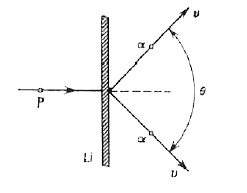Protons accelerated by a potential difference of 6.8 MV bombard a stationary lithium target. The collision of a proton with a nucleus of Li7 isotope results in the birth of two alpha-particles which separate symmetrically with respect to the direction of the proton beam. Find the kinetic energy and the separation angle of the alpha-particles.
The correct Answer is:12.1MeV;158.4∘.
The nuclear reaction takes the form 1H1+3Li7=22He4. The kinetic energy of the alpha-particle is found from the law of conservation of energy which for this reaction is of the form
2Kα=(MH+MLi−2Mα)×931.5+KH=24.2MeV
SInce the kinetic energy of the alpha-particle turns out to be much lower than its rest energy, the alpha-particles produced in the reaction are nonrelativistic. The separation angle is found from the law of conservation of momentum
pH=2pαcosθ2
But for a nonrelativistic particle p=√2mK, so
cosθ2=12√mHKHmαKα

Similar Questions
A proton is bombarded on a stationary lithium nucleus. As a result of the collision, two α-particles are produced. If the direction of motion of the α-particles with the initial direction of motion makes an angles cos−1(1/4), find the kinetic energy of the striking proton. Given, binding energies per nucleon of Li7 and He4 are 5.60 and 7.06 MeV, respectively.
(Assume mass of proton ≈ mass of neutron).View SolutionA proton is bombarded on a stationary lithium nucleus. As a result of the collision, two α-particles are produced. If the direction of motion of the α-particles with the initial direction of motion makes an angles cos−1(1/4), find the kinetic energy of the striking proton. Given, binding energies per nucleon of Li7 and He4 are 5.60 and 7.06 MeV, respectively.
(Assume mass of proton ≈ mass of neutron).View Solution
Knowledge Check
- Question 1 - Select One
A proton and and α- particle are accelerated through a potential difference of 100V. The ratio of the wavelength associated with the proton to that associated with an α - particle is
A√2:1B2:1C2√2:1D12√2:1 - Question 2 - Select One
A proton and an α particle accelerated through the same potential difference enter a region of uniform magnetic field normally if the radius of the proton orbit is 10 cm ten radius of α particle is
A10cmB10√2cmC20cmD5√2cm - Question 3 - Select One
An α-particle and a proton are accelerated in such a way that they get the same kinetic energy. What is the ratio of their de Broglie wavelengths?
A1:1B1:2C1:3D3:2
Proton with kinetic energy T=1.0MeV striking a lithium target induce a nuclear reaction p+Li7→2He4. Find the kinetic energy of each alpha-particles and the angle of their divergence provided their motion directions are symmertical with respect to that of incoming protons.
View SolutionIf a proton, deuteron, and alpha particle on being accelerated by the same potential difference enters perpendicular to the magnetic field, then the ratio of their kinetic energies is
View SolutionIf an alpha particle and a proton are accelerated from rest by a potential difference of 1MeV, then the ratio of their kinetic energies will be
View SolutionA proton and an alpha particle are accelerated through the same potential difference. The ratio of the wavelengths associated with the proton to that associated with the alpha particle is
View SolutionAn α particle and a proton are accelerated in such a way that they get the same kinetic energy. What is the ratio of their de- broglie wavelengths ?
View Solution

